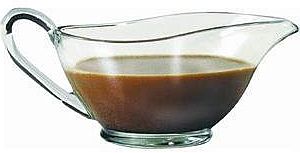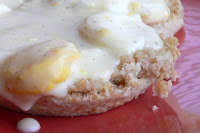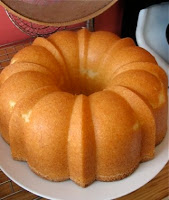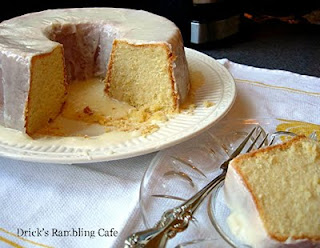Making Proper Gravy
How to Make Gravy Like Momma
 Southern Kitchen Classics: Gravy Making
Southern Kitchen Classics: Gravy MakingMany essential things come from the kitchens of our parents and grandparents. Many are of life's lessons, a few about cooking and a few with recipes. This one is about cooking.
To our ancestors, making a sauce or gravy was not science but today, we know it is just that. Both sauce and gravy consists of thickening agents combined with a aqueous mixture to increase its viscosity without substantially modifying its other properties, such as taste. To do so properly provides body, increases stability, and improves suspension of added ingredients. Thickening agents include: polysaccharides (starches, vegetable gums, and pectin), proteins (eggs, collagen, gelatin, blood albumin) and fats (butter, oil and lards). All purpose flour is the most popular food thickener, followed by cornstarch, arrowroot, potato or tapioca. All of these thickeners are based on starch as the thickening agent. But unlike the last four agents, only all purpose flour is widely used in making gravy as the cornstarch (which is actually a flour too) and root crops yields clear, translucent gravies and will not brown as in making a roux. source
Now in the south and I mean deep south, the terms gravy and sauce are the same. In fact, sauce is rarely use in many parts and as I remember from my youth, 'gravy is spooned from the pan and sauce is served at the table'. Here, I use gravy as a compatible word.
There are many ways to make gravy using flour. Three of the basics are:

- using a slurry which is flour and cold liquid combined and whisked into a base liquid before raising the temperature needed to thicken the sauce. Using this method does allow you to skip the addition of fat.

- by making a paste of flour and fat (Beurre Manié) and whisking it into a heated base liquid to thicken

- and the best is by making a roux of flour and fat ... period
By using the first two methods to make a gravy, the sauce will not maintain stability and both require a long time to cook out the raw flour taste. By starting with a roux, which is mostly equal part flour and a fat, you cook to break down the flour and rid that raw taste before adding the base liquid.
 Now, the best pan to use for a gravy is of course a saucier, but a rounded bottom skillet will do nicely too. And, if you are making dark roux, you want to make sure your saucier, pot or skillet is a heavy, 3-ply or cast iron vessel. A good whisk with many tines along with a flat bottom spatula are the basic tools in making roux for gravy.
Now, the best pan to use for a gravy is of course a saucier, but a rounded bottom skillet will do nicely too. And, if you are making dark roux, you want to make sure your saucier, pot or skillet is a heavy, 3-ply or cast iron vessel. A good whisk with many tines along with a flat bottom spatula are the basic tools in making roux for gravy.So what is the best ratio of ingredients: According to Alton Brown, 1 cup liquid with 1 ounce flour and 1 ounce fat by weight is the trick. source So if you need 3 cups of gravy, increase all by 3. Momma did not weigh out her ingredients, nor do I. Like her, I do the tablespoon method and it goes like this: for every 1 cup of liquid, make a roux using 2 tablespoons of fat with 2 tablespoons of all purpose flour.
Now, let's get to making gravy. Melt the fat (lard, oil or butter) over medium heat and when melted hot, whisk in the flour all at once. Whisk good for 2 minutes which the roux should start to thin out or spread a little on its own. At this point, turn down the heat to low and continue whisking. It is here where the level of thickening power is achieved and it is here where depending on how long you stir and cook it determines the color and flavor.
 A rule for type of roux, thickening power and cooking time on low heat goes something like this:
A rule for type of roux, thickening power and cooking time on low heat goes something like this:
White - 1 part roux - cooks about 5 minutes
Blond - 2 parts roux- about 20 minutes of stirring
Tan Chocolate - 3 parts roux - plan on up to a good hour
Dark Creole Brick Red - 4 parts roux - takes up to 2 hours
You see, the lighter the roux, the more thickening power it will have and likewise, the darker it is the less, meaning the more you will need to thicken the same amount of liquid.
I have always followed Momma's way introducing the roux to the liquid base of both ingredients being hot or at least the liquid being on the warm side and the roux cooled down a bit by removing off-heat or caramelizing vegetables before the liquid's melding. Chef Brown's axiom is that the roux should be room temperature and the liquid base hot. I mention this only because I have much faith in Sir Alton. But momma's way has never let me down. Either way, slowly whisk in about 1/3 of liquid into the roux over high heat forming a paste. This will ensure a smooth, binding gravy. When thickened, add another 1/3 of liquid and whisk until smooth. By using the roux method, the gravy will thicken quickly, at about 150 degrees F. or about the time you first start to see bubbling action breaking the surface. Add more liquid, tablespoons at a time until desired consistency. At this time, your gravy is ready.
Note that gravy made with a flour roux will also cool down quicker than say one made the Beurre manié method. Therefore, it is necessary to thin a roux base gravy down a tad more than you would think knowing it thickens as it cools especially if serving at the table.
As I mention in our family cookbook, Grits to Guacamole, Momma had a flair of making various sauces and would stand over the stove and then cunningly use that same labor intensive sauce over heated vegetables from the freezer. Some of her best sauces or gravies come from a roux base including these:
 |
| Béchamel / Creole Creamed Eggs |
Mornay - taking the white gravy and adding cayenne along with Gruyere and Parmesan
 |
| Alfredo / Creamy Chicken Alfredo |
Soubise - classic Béchamel with the addition of shallots or onion
 |
| Velouté / Sweet Onion Apple Pear Gravy |
Paprika - a Velouté with the addition of onion, added butter, paprika and heavy cream
 |
| Cheese / Baked Macaroni and Pimento Cheese |
 |
| Saw Mill / Fried Chicken Fillets |
Red Eye Gravy - flour roux with country ham drippings and coffee
 |
| Tomato Gravy / Creole Daube |
Brown Gravy / Momma's Meatloaf
Brown Gravy - pan drippings from cooked meat stirred into a darkened flour based roux



Great post Drick.
ReplyDeleteHonestly I have no idea how folks eat mashed potatoes without gravy you outdid yourself and your mom taught you right you aced this one ...
ReplyDeleteGreat post Drick. All I know about gravy is that I make a mean white gravy with left over chicken crumbs, flour, milk, and a couple tablespoons of hot crisco from frying chicken. I learned a lot about gravy from this post.
ReplyDeleteWell now, this is the definitive post on making southern-style gravy! Learned a lot.
ReplyDelete